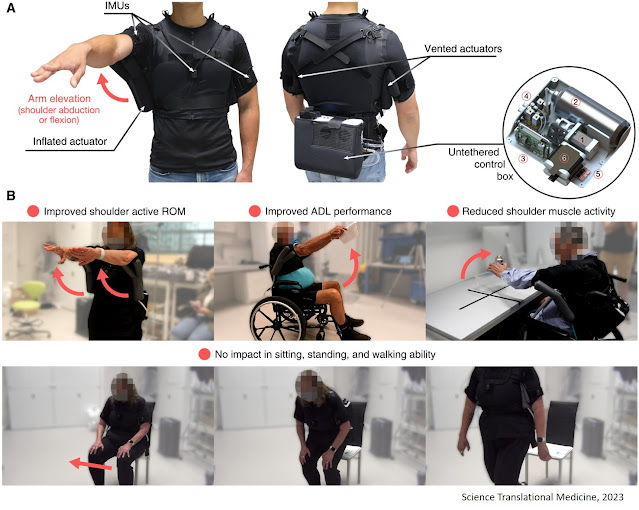Some
30,000 people in the U.S. are affected by amyotrophic lateral sclerosis
(ALS), also known as Lou Gehrig’s disease, a neurodegenerative
condition that damages cells in the brain and spinal cord necessary for
movement.
Now, a team of researchers has developed a soft robotic wearable capable
of significantly assisting upper arm and shoulder movement in people
with ALS.
“This study gives us hope that soft robotic wearable technology might
help us develop new devices capable of restoring functional limb
abilities in people with ALS and other diseases that rob patients of
their mobility,” says the senior author on Science Translational Medicine paper reporting the team’s work.
The assistive prototype is soft, fabric-based, and powered cordlessly by a battery.
“This technology is quite simple in its essence,” says the paper’s first
author, where the wearable was designed and built. “It’s basically a
shirt with some inflatable, balloon-like actuators under the armpit. The
pressurized balloon helps the wearer combat gravity to move their upper
arm and shoulder.”
To assist patients with ALS, the team developed a sensor system that
detects residual movement of the arm and calibrates the appropriate
pressurization of the balloon actuator to move the person’s arm smoothly
and naturally. The researchers recruited ten people living with ALS to
evaluate how well the device might extend or restore their movement and
quality of life.
The team found that the soft robotic wearable – after a 30-second
calibration process to detect each wearer’s unique level of mobility and
strength – improved study participants’ range of motion, reduced muscle
fatigue, and increased performance of tasks like holding or reaching
for objects. It took participants less than 15 minutes to learn how to
use the device.
“These systems are also very safe, intrinsically, because they’re made
of fabric and inflatable balloons,” the first author says. “As opposed
to traditional rigid robots, when a soft robot fails it means the
balloons simply don’t inflate anymore. But the wearer is at no risk of
injury from the robot.”
The senior author says the soft wearable is light on the body, feeling
just like clothing to the wearer. “Our vision is that these robots
should function like apparel and be comfortable to wear for long periods
of time,” the author says.
The current prototype developed for ALS was only capable of functioning
on study participants who still had some residual movements in their
shoulder area. ALS, however, typically progresses rapidly within two to
five years, rendering patients unable to move – and eventually unable to
speak or swallow. The team is exploring potential versions of assistive
wearables whose movements could be controlled by signals in the brain.
Such a device, they hope, might someday aid movement in patients who no
longer have any residual muscle activity.
Feedback from the ALS study participants was inspiring, moving, and motivating, the first author says.
“Looking into people’s eyes as they performed tasks and experienced
movement using the wearable, hearing their feedback that they were
overjoyed to suddenly be moving their arm in ways they hadn’t been able
to in years, it was a very bittersweet feeling.”
The team is eager for this technology to start improving people’s lives,
but they caution that they are still in the research phase, several
years away from introducing a commercial product.
“Soft robotic wearables are an important advancement on the path to
truly restored function for people with ALS. We are grateful to all
people living with ALS who participated in this study: it’s only through
their generous efforts that we can make progress and develop new
technologies,” the author says.
https://www.science.org/doi/10.1126/scitranslmed.add1504

